The journey of recorded music is a fascinating tale, echoing through time, from the earliest phonographs to today’s digital streaming platforms. It’s a story of relentless innovation, driven by humanity’s enduring love for melody and rhythm.
This article will guide you through the milestones of recorded music, exploring how each era left its indelible mark on the soundscape of today. You’ll discover how technological advancements shaped the way we create, consume, and connect with music. So, sit back and let’s delve into the captivating history of recorded music.
History of Recorded Music

Technological advancements paint a riveting chronicle in the sphere of recorded music. Dating back to the 19th century, the Phonograph stands as a starting point. Invented by Thomas Edison in 1877, this device could both record and reproduce sound, utilizing vibrations etched into a tinfoil sheet.
Two decades later, Emile Berliner’s Gramophone (1891) charted a new course. This device imprinted sound onto flat discs – a format familiar today – and increased accessibility to recorded music. The 20th century saw a flurry of innovations: the electric microphone (1920s), the vinyl LP (1950s), and the audio cassette and 8-track (1960s). Each progression eased the process of recording, storing, and listening to music, bringing it further into homes worldwide.
Technologies of the latter part of the century, such as the Compact Disc (CD) and digital platforms, transitioned music from physical medium to digital form. Topping it all, online streaming services emerged at the start of the 21st century, reshaping how music is distributed and consumed. This road map of technological evolution unearths the seismic shifts in recording technologies and their enduring influence on our sonic experiences.
Key Milestones in the History of Recorded Music

Touching on Thomas Edison’s phonograph in 1877, music recording’s paramount journey began. Sparked in innovation, 1891 saw Emile Berliner develop the Gramophone, an invention that offered a drastic variation in recording techniques.
The year 1925 presented the electric microphone, expanding the horizons of voice and instrument recording. Innovation permeated the mid-20th century, evidenced by the introduction of the vinyl LP in 1948. This format, sophisticated for its time, preserved high-fidelity sound and was a pioneer in shaping music storage.
Pioneering Figures in Recorded Music

Eminent inventors stamped their indelible marks on the history of recorded music. Thomas Edison stands as the key initiator, inventing the phonograph in 1877. It’s through his invention that the era of capturing sound began. Notably, Emile Berliner followed by introducing the Gramophone in 1891, a device that enhanced sound quality, thus elevating listener experiences.
Pushing forward, the introduction of electric microphones in 1925, primarily credited to Western Electric, brought recordings from whispery voices to a full auditory spectrum. Subsequently, Peter Goldmark of Columbia Records contributed significantly by presenting the vinyl LP in 1948.
The 21st century welcomed online streaming services, propelling recorded music into the digital realm. Companies such as Spotify, Apple Music, and Pandora become significant in music distribution, reshaping how listeners engage with music. Recognizing these visionaries emphasizes their transformative roles in sculpting the landscape of recorded music across centuries.
Major Trends and Influences in Recorded Music
From Edison’s phonograph to Berliner’s Gramophone, the history of recorded music is a testament to human creativity and innovation. The advent of the electric microphone, vinyl LP, and audio cassette marked significant milestones, redefining how music was recorded and consumed. As technology advanced, so did the music industry. The digital era brought about a seismic shift, with platforms like Spotify and Apple Music revolutionizing distribution and listener engagement. Pioneering figures have left indelible marks, shaping the industry with their transformative roles. Their contributions underscore the dynamic nature of recorded music, constantly evolving and adapting to societal changes. It’s a fascinating journey that continues to unfold, promising new trends and influences in the future.

